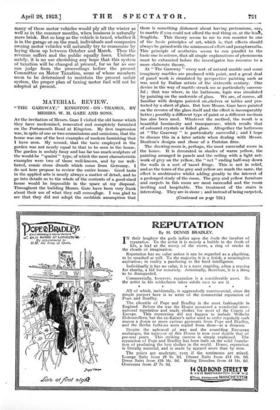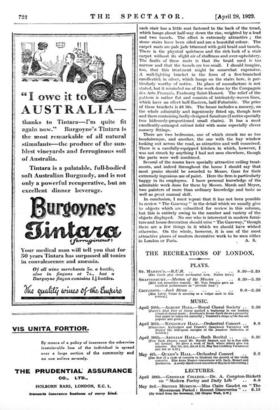MATERIAL REVIEW.
" THE GAZEWAY;" KINGSTON - ON - THAMES, BY MESSRS. W. H. GAZE AND SONS.
AT the invitation of Messrs. Gaze I visited the old house which they have modernized, renovated and completely furnished on the Portsmouth Road at Kingston. My first impression was, in spite of one or two commissions and omissions, that the house was one of the best examples of modern furnishing that I have seen. My second, that the taste employed in the garden was not nearly equal to that to be seen in the house. The garden is unduly fussy and has far too much sculpture of the would-be " quaint " type, of which the most characteristic examples were two of those well-known, and by me well- hated, comic stone dwarfs which come from Germany. I do not here propose to review the entire house. Good taste in the applied arts is nearly always a matter of detail, and to go into details as to the whole of the contents of a good-sized house would be impossible in the space at my disposal. Throughout the building Messrs. Gaze have been very frank about their use of what they call camouflage. I was glad to see that they did not adopt the snobbish assumption that there is something dishonest about having pretensions, say, to marble if you could not afford the real thing or, at the leagt, Scagliola. This theory seems to me to run counter to one of the basic principles of art, which is, that effects should always be gained with the minimum of effort and paraphernalia. This principle of aesthetics seems to run parallel to the basic one in science, that all simple explanations of phenommia must be exhausted before the investigator has recourse to a more elaborate theory.
At " The Gazeway " every sort of natural marble and some imaginary marbles are produced with paint, and a great deal of panel work is simulated by perspective painting such as was used by Italian artists of the sixteenth century. One device in the way of marble struck me as particularly success- ful ; that was where, in the bathroom, lapis was simulated by painting on the underside of glass. We are, of course, all familiar with designs painted on .shelves or tables and pro- tected by a sheet of glass. But here Messrs. Gaze have painted on the reverse of the glass itself and the effect is incomparably better ; possibly a different type of paint or a different medium has also been used. Whatever the method, the result is a beautiful luminosity and transparence, which recalls that of coloured crystals or foiled glass. Altogether the bathroom at " The Gazeway " is particularly successful ; and I hope to discuss this in a later article when dealing with Messrs. Doulton's designs and _those of a Parisian firm.
The drawing-room is, perhaps, the most successful room in the house. It is decorated in shades of warm yellow, the painting arranged in panels and the ceiling with a light net- work of grey on the yellow, the " net " ending half-way down the walls in a sort of tassel fringe. This is not in relief, and as the tones of the grey and yellow are much the same, the effect is unobtrusive whilst adding greatly to the interest of a prolonged study of the room. The grey and yellow furniture and carpets in this room are most successful and the room inviting and hospitable. The treatment of the stairs is interesting. They are in stone ; and instead of being carpeted, (Continued on page 722.) each stair has a little mat fastened to the back of the tread, which hangs about half-way down the rise, weighted by a lead and two tassels. The effect is extremely attractive ; the stone stairs have been oiled and are a beautiful colour. The carpet mats are pale jade trimmed with gold braid and tassels. There is the physical quietness and the rich look of a stair carpet without its slight air of stuffiness and over-upholstery. The faults of these mats is that the braid used is too narrow and that the tassels are too small. I should imagine, too, that this treatment might be somewhat expensive. A wall-lighting bracket in the form of a five-branched candlestick in silver, which hangs on the stairs here, is par- ticularly worthy of notice. Its place of manufacture is not stated, but it reminded me of the work done by the Compagnie des Arts Francais, Faubourg Saint-Honore. The relief of the pattern is rather flat and consists of intricately-woven lines, which have an effect half-Eastern, half-Futuristic. The price of these brackets is £8 10s. The house includes a nursery, on the whole admirably and ingeniously fitted up, though here and there containing badly-designed furniture (I notice specially two hideously-proportioned small chairs). It has a most excellently-arranged cabinet toilet with some especially clever nursery fittings.
There are two bedrooms, one of which struck me as too boudoiresque, and another, the one with the bay window looking out across the road, as attractive and well conceived. There is a carefully-equipped kitchen in which, however, I was not struck by anything I had not seen elsewhere, though the parts were well combined.
Several of the rooms have specially attractive ceiling treat- ments, and indeed throughout the house I should say that most praise should be awarded to Messrs. Gaze for their extremely ingenious use of paint. Here the firm is particularly happy in its employees. I have personal knowledge of the admirable work done for them by Messrs. Marsh and Meyer, two painters of more than ordinary knowledge and taste as well as great manual skill.
In conclusion, I must repeat that it has not -been possible to review " The Gazeway" in the detail which we usually give to objects which are submitted for review in this column, but this is entirely owing to the number and variety of the objects displayed. No one who is interested in modern furni- ture and house decoration should miss " The Gazeway," though there are a few things in it which we should have wished otherwise. On the whole, however, it is one of the most attractive pieces of modern decorative work to be seen either



















































 Previous page
Previous page